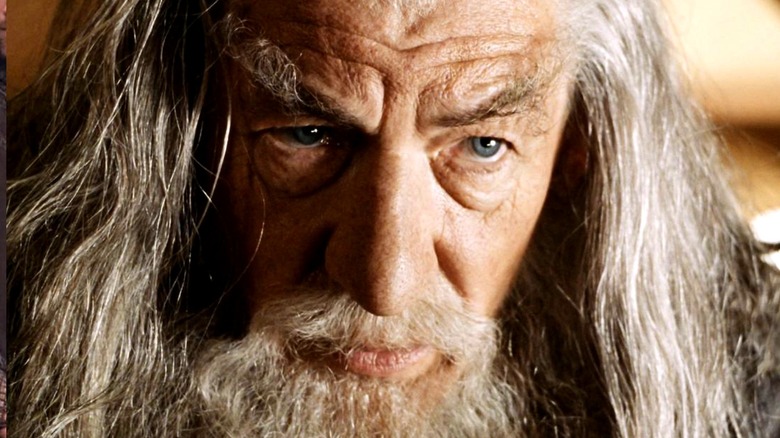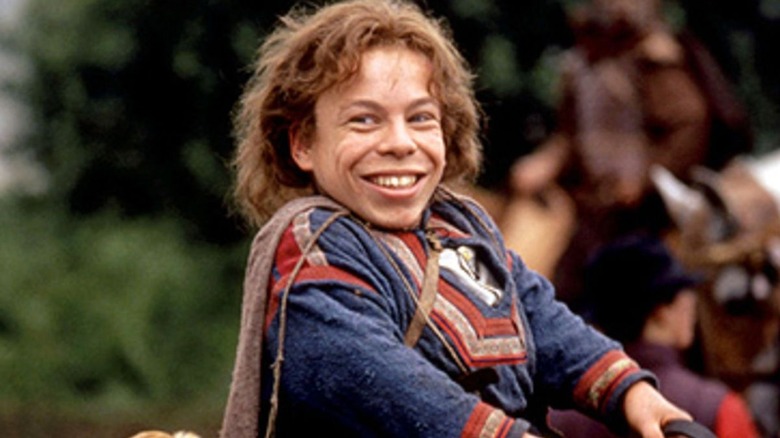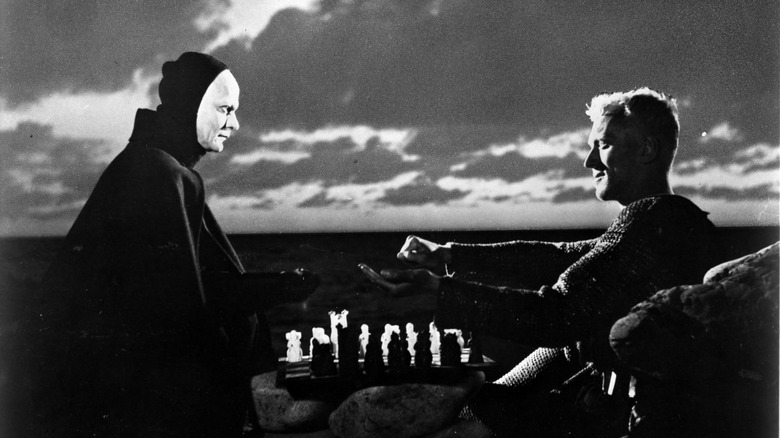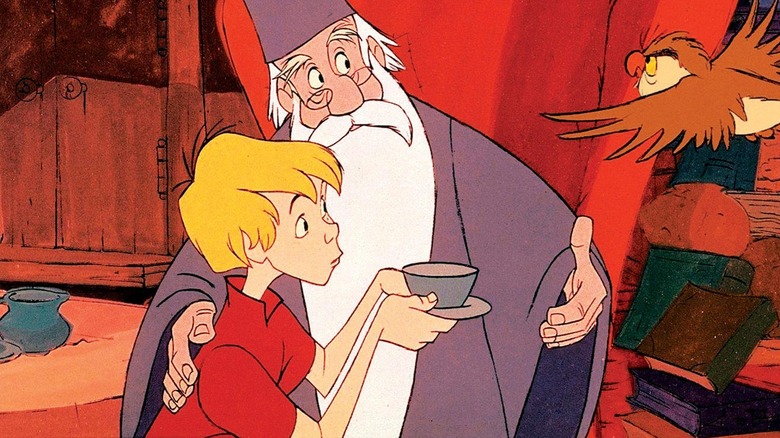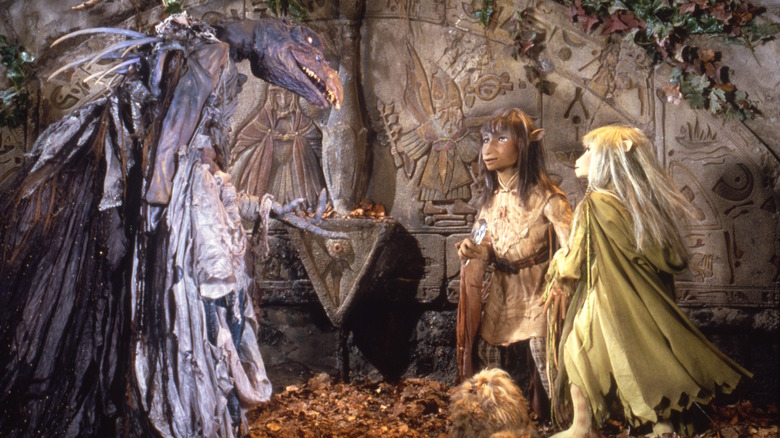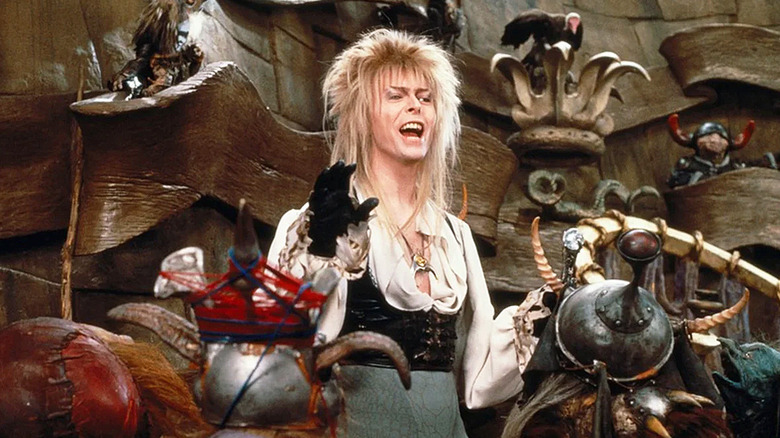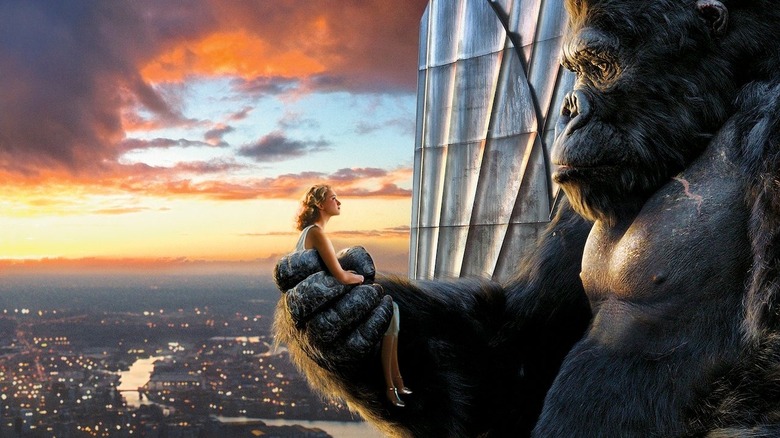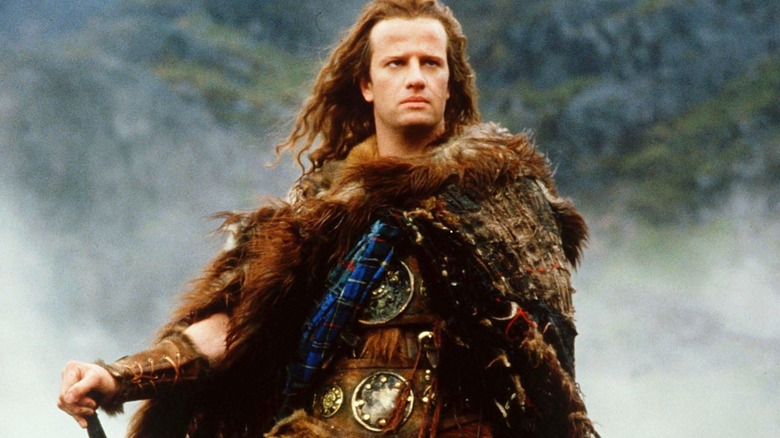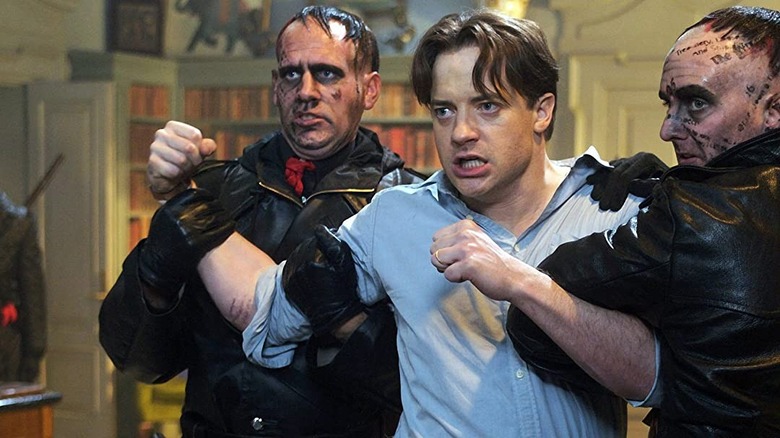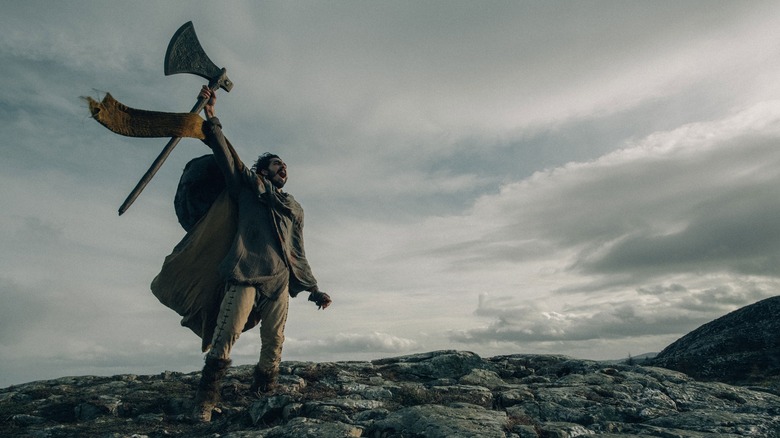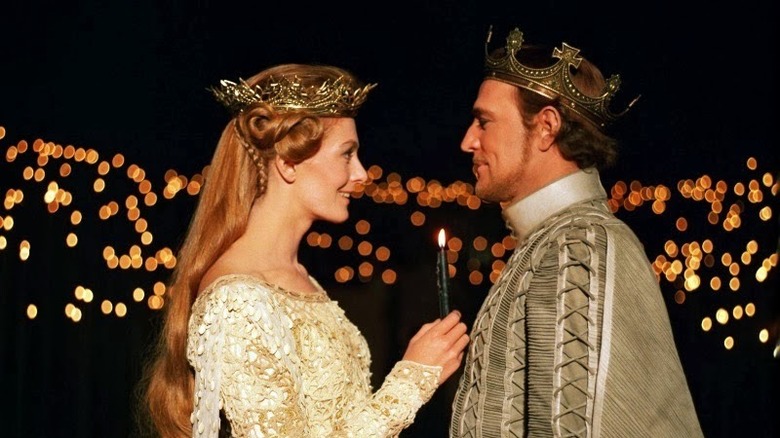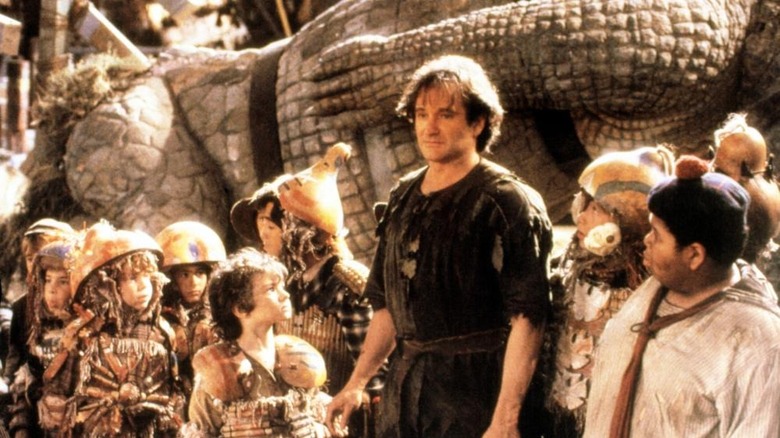Movies Like The Lord Of The Rings That Are Definitely Worth Watching
"The Lord of the Rings" trilogy is among the most perfect movie trilogies of all time. Against all odds, Peter Jackson's meticulous adaptation of J.R.R. Tolkien's beloved trilogy of novels lived up to the significant hype, pleasing both fans of the books and complete newcomers. Tolkien spent years crafting the languages, characters, creatures, history, and mythology of Middle-earth, and Jackson showed a similar attention to detail when he brought the sprawling story to the big screen. The films were shot back-to-back in Jackson's home of New Zealand, where the incredible crew took on the challenge of bringing Middle-earth to life.
It's tough to determine which of the three films is the best. "The Fellowship of the Ring" is a wonderfully patient beginning that shows how the innocent characters are forced to adjust to the dangerous quest. "The Two Towers" is a war epic showing the human and political binds of conflict. "The Return of the King" is a jaw-dropping conclusion that wraps up all the story threads in a satisfying way. Upon release, the entire trilogy received critical acclaim and broke box office records, and remains a favorite to this day.
The success of the "The Lord of the Rings" trilogy showed that audiences' interest in fantasy films was high. Epic quests featuring brave heroes, fearsome villains, and exotic creatures are inherently cinematic, and while "The Lord of the Rings" films are the high point of the entire genre, the following movies are also definitely worth watching.
Willow
One lifelong fan of J.R.R. Tolkien's novels was George Lucas, who was inspired by Tolkien's writing when he created "Star Wars." Later, Lucas decided that he wanted to reinvent the fantasy genre for a new generation, the same way he had relaunched science fiction with "Star Wars" and adventure serials with "Indiana Jones." Drawing on a script he'd written in the '70s called "Munchkins," Lucas enlisted his former "American Graffiti" star Ron Howard to help him craft an original fantasy hero.
Like Jackson's WETA team committed to building a fantasy world in precise detail with "The Lord of the Rings," Lucasfilm was intent on creating a distinct mythical world from the ground up. In the film, a hobbit-like Nelwyn, Willow (Warwick Davis), is a father in a small, innocent village similar to the Shire. When the Nelwyn discover an infant child has washed up on their shores, the mercenary Madmartigan (Val Kilmer) approaches them and offers to take the baby himself. Willow refuses, and decides to return the baby home himself.
Willow learns that the child will fulfill a prophecy that will vanquish the wicked Queen Bavmorda of Nockmaar (Jean Marsh), and that the evil monarch is searching throughout the Mother World for its location. Bavmorda's daughter Sorsha (Joanne Whalley) tracks Willow down, but Madmartigan offers him protection. Willow and Madmartigan have a fun relationship, similar to that of Aragorn and the Hobbits.
Dragonslayer
The fantasy genre was successful in the 1980s, but there were a few notable box office disappointments. Chief among them was 1981's "Dragonslayer." It's unfortunate that the film underperformed financially and failed to launch a franchise, because Matthew Robbin's sword-and-sorcery epic is a beautifully crafted visual spectacle with one of the greatest cinematic dragons of all-time, rivaling the winged creatures ridden by Tolkien's Nazgul. Like "The Lord of the Rings," "Dragonslayer" follows an unlikely hero who must contend with a cruel world that he's never been exposed to, and his innocence makes the story much more heartwarming.
In the medieval kingdom of Urland, the young magical acolyte Galen Bradwarden (Peter MacNiccol) trains under the ancient wizard Ulrich of Cragganmore (Ralph Richardson). Ulrich hones Galen's abilities as the 400-year-old dragon Vermithrax Pejorative terrorizes larger castles. In order to stop his city from being destroyed, King Casiodorus (Peter Eyre) sacrifices two young virgin girls to the dragon every year. He seeks Ulrich's help in taming the beast, and dispatches his ruthless warrior Tyrian (John Hallam) to recruit the elderly man. Tyrian murders Ulrich, leaving Galen with the responsibility of saving the entire kingdom.
Galen falls in love with the young warrior Valerian (Caitlin Clarke), who joins him on the quest to slay Vermithrax Pejorative. Valerian disguises herself as a man, but once her deceit is revealed she fears that she could be selected for sacrifice by the king. Their romance is earnest, and their duel with the dragon is one for the ages.
The Seventh Seal
"The Lord of the Rings" is a very reflective trilogy, with meditations on the ramifications of death that expose a mature side of the fantasy genre. While sagas like "The Witcher" and "Game of Thrones" frequently shock viewers with quick, surprising character deaths, each loss in "Lord of the Rings" is a pivotal moment in the story, and the films give the other characters time to mourn. It's the corruption, fall from grace, redemption, and ultimately heroic demise of Boromir (Sean Bean) that shatters the group at the end of "The Fellowship of the Ring," and the loss of the noble Gondorian warrior has major ramifications throughout the trilogy.
Similarly, Ingmar Bergman's classic "The Seventh Seal" explores the very nature of death in vivid detail. Few images in sword-and-sorcery cinema are quite as iconic as the chess match from Bergman's 1957 masterpiece. The film follows key conversations between the noble knight Antonius Block (Max von Sydow) and Death (Bengt Ekerot) himself as they match wits on a secluded beach.
Block returns from fighting within the Crusades, where he's seen his fair share of bloody brutality, and finds that the home that once provided comfort has been ravaged by the Great Plague. He attempts to survive his encounter with the cloaked figure for as long as possible, and their game lasts for the entirety of the film. It's a great introduction to Bergman, especially for younger film fans interested in the fantasy genre.
The Sword in the Stone
While Tolkien was outwardly dismissive of Arthurian legends, it's not hard to see links between "The Lord of the Rings" and the mythology of Camelot, and the story of King Arthur has had a profound influence on the fantasy genre as a whole. Appropriately, Arthur has been depicted countless times on screen, and some adaptations are better than others. Guy Ritchie tried his hand recently with the stylized, action-oriented Charlie Hunnam vehicle "King Arthur: Legend of the Sword," and Antonie Fuqua attempted to take a more realistic look at the legend with Clive Owen in "King Arthur." Arthur's adventures have been adapted into various genres: 1975's "Monty Python and the Holy Grail" is one of the greatest spoof movies of all time, while 1995's "First Knight" approached the fable as a '90s romantic melodrama, centering on the love triangle between Arthur (Sean Connery), Lancelot (Richard Gere), and Guinevere (Julia Ormand).
However, these adaptations all tend to center on Arthur's later exploits during the Crusades, and highlight the adventure aspects. Disney's animated classic, 1963's "The Sword in the Stone," looked at Arthur's origins, back when the future king was once a meek and innocent child similar to Frodo Baggins. Like Frodo, the young squire dreams of faraway adventures, but doesn't seek out glory or violence. His inherent goodness is what makes him worthy of lifting the sword Excalibur from the stone, similar to the reasons why Gandalf selects the naive Frodo to carry the burden of the One Ring.
The Dark Crystal
One of the reasons why "The Lord of the Rings" was so successful was the meticulous detail paid to creating the world of Middle-earth from scratch. Every location, from the welcoming and homely Shire to the epic kingdoms of Gondor and Rohan, was built from scratch in New Zealand and imbedded with latent details that pleased Tolkien enthusiasts. Anyone who's viewed the extensive collection of behind-the-scenes featurettes on the extended edition DVDs and Blu-rays knows of the breathtaking task that the crew took on; there are even small touches, like the interior linings of characters' jackets, that viewers couldn't possibly pick up on.
"The Muppets" creator Jim Henson showed a similar diligence with his 1982 dark fantasy epic "The Dark Crystal." Henson is one of the great pioneers of puppetry, and while the success of "The Muppet Show" proved that he could tell stories that appealed to both children and adults, Henson had more ambitious goals in mind. He wanted to create a world devoid of any humans entirely. As such, "The Dark Crystal" is set in the mythical world of Thra, where the titular crystal was shattered and the land forever divided between two races, the power-hungry Skeksis and the peaceful uRru Mystics.
The Skesis seek the Crystal in order to receive eternal life, where the Mystics only use it for good. Meanwhile, the diminutive Gelflings play a role similar to the hobbits, with an innocence that belies the great strength they exhibit when the fate of the world falls on their shoulders.
Labyrinth
Fantasy films can become so obsessed with building out their mythology that the characters become secondary. Tolkien subverted these concerns by finding a great framing device for "The Lord of the Rings" by telling the story through Frodo's perspective; ultimately, it's a coming-of-age story. The innocent hobbit characters are clearly inspired by the young British soldiers of World War I (which included Tolkien) who were forced to leave their homes and become heroes. Frodo's sensitivity to cruelty makes him an engaging hero, and he develops a more mature worldview as he's exposed to the different sides of Middle-earth.
Jim Henson also focused on the coming-of-age aspect of the heroic journey with his 1986 film "Labyrinth." "Labyrinth" contains enough overt adult themes that it's hard to consider it a traditional fairy tale, despite the young protagonist. The film follows Sarah (Jennifer Connelly) as she enters a mysterious maze in search of her infant half-brother, Toby. Sarah's journey to escape the labyrinth represents her transition to adulthood, and she's riddled with guilt about her prior desires for Toby to disappear.
Like "The Dark Crystal," "Labyrinth" features the incredible puppetry of Jim Henson's Creature Shop. The film is best known for the memorable performance by David Bowie as the main villain Jareth, the Goblin King who kidnapped Toby. Bowie helped develop the film's soundtrack, and wrote the songs "Underground", "Magic Dance", "Chilly Down", "As The World Falls Down" and "Within You" exclusively for the film.
King Kong
"The Lord of the Rings" was renowned for its practical effects and real sets, but it also featured some of the most cutting-edge developments in the history of computer-generated imagery. Chief among them were the advancements in motion capture and the creation of Gollum, played by Andy Serkis in a role that brought respect to the craft. While Jar Jar Binks became the first fully CG supporting character ever in "Star Wars: Episode I — The Phantom Menace" a few years prior, Serkis' performance was unprecedented. He showed that mo-cap was a viable acting pursuit, and that it could result in a memorable character who was unique, tragic, and terrifying all at once.
Serkis would only continue to pioneer motion capture performances, and right after "The Lord of the Rings" he re-teamed with Peter Jackson to explore one of the most famous movie monsters of all time. Jackson has often cited the original 1933 "King Kong" as his favorite film, and his 2005 remake is a sensitive reimagining that pays tribute to the groundbreaking classic. However, Jackson's film spends more time with the titular ape himself, and Serkis makes Kong a compelling character capable of expressing a variety of emotions. His unique mannerisms and expressions make the conclusion even more tragic.
Like "The Lord of the Rings," Jackson knew he was taking on material with a loyal fanbase, and he spared no expense in building detailed sets and designing a complex, fully-realized world to bring Skull Island to life.
Highlander
The pressures of immortality are ever present throughout "The Lord of the Rings." Arwen (Liv Tyler) is warned by her father Elrond (Hugo Weaving) that a marriage to Aragorn is bound to leave her heartbroken, as she must either forsake everlasting life and choose mortality or live with the knowledge that, despite his extended life, the Gondorian ranger will ultimately die and leave her to raise their child alone.
1986's fantasy-action film "Highlander" is best remembered for its fight sequences, but the film's depiction of immortality is surprisingly nuanced. The 16th-century Scottish warrior Connor MacLeod (Christopher Lambert) is exiled from his village after he miraculously recovers from what should've been a fatal wound. Connor falls in love with Heather MacDonald (Beatie Edney), and soon learns that he's an immortal — he can only be killed by being beheaded, and, if he decapitates another immortal, he'll take their power. After an elderly Heather dies in his arms, Connor tracks his nemesis, the Kurgan (Clancy Brown), throughout history, ultimately battling him in modern day New York. Like "The Lord of the Rings," "Highlander" uses a creative way of integrating flashbacks to make the story more emotional.
Gandalf is one of the greatest mentor characters in all of storytelling, and "Highlander" also has a great wise older figure. Sean Connery gives one of his best performances ever as the immortal Egyptian warrior, Juan Sánchez-Villalobos Ramírez.
Inkheart
In the wake of the unprecedented success of "The Lord of the Rings," many fantasy films based on beloved novels aimed to create similarly successful franchises. Unfortunately, many of these films bombed, and audiences looking to diversify their fantasy viewings ultimately turned to television shows like "Game of Thrones." Many of these botched franchise ventures weren't good enough to justify multiple entries; after the disastrous first films, no one was asking for a sequel to "Eragon," "The Dark Tower," or "The Giver." However, 2008's "Inkheart" is worthy of critical reappreciation, as, despite its financial failure, the film has a lot of merit.
"Inkheart" is based on a trilogy of novels by Cornelia Funke. It follows book lover Mortimer Folchart (Brendan Fraser), who loves exploring fairy tales with his beloved wife, Resa (Sienna Guillory). After reading an old copy of a book called "Inkheart" out loud, Resa is transported into the fantasy world depicted in its pages, while the fire-wielding Dustfinger (Paul Bettany) appears in the real world. Both Mortimer and Dustfinger are heartbroken when the spell can't be reversed, separating them both from their true loves.
Mortimer travels the world in search of another copy of "Inkheart," and gradually reveals the magical events to his 12-year-old daughter Meggie (Eliza Bennett). Meggie is a great audience avatar, as she learns about the "Inkheart" world at the same time that viewers do.
The Green Knight
"The Lord of the Rings" isn't just one of the most sweeping, epic adventures in film history, but a visual delight. The beautiful imagery from cinematographer Andrew Lesnie illuminated the gorgeous environments in immaculate detail, and few modern fantasy films have been able to capture the same depth or luster. However, in 2021, the brilliant writer-director David Lowery created a breathtaking visual journey with his reimagining of Arthurian mythology in "The Green Knight." With themes of mortality, nobility, and the traumas of heroism, "The Green Knight" is both a thematic and visual cousin of "The Lord of the Rings."
Based on the 14th-century poem "Sir Gawain and the Green Knight," a work that Tolkien himself translated to great acclaim, the film follows the adventures of King Arthur's nephew (Dev Patel). The brash young Gawain is noble but reckless, and endangers Camelot after he attempts to slay the fearsome Green Knight (Ralph Ineson). The Green Knight survives a beheading and promises he will return to Camelot the following year if Gawain does not seek him out and offer his own head in return.
Camelot
Music is an integral part of "The Lord of the Rings." Outside of the great score by Howard Shore, the films incorporate beautiful songs with moving lyrics, including "Into the West" and "May It Be." Each kingdom has a distinct musical theme, and one of the most touching scenes in "The Return of the King" is when Pippin sings "Edge of Night" as Faramir and the Gondorian warriors ride into battle. Medieval fantasy and music go hand in hand, and no film depicts their close-knit relationship better than the 1967 adaptation of the stage musical "Camelot."
"Camelot" is among the better Arthurian adaptations, and earnestly explores the forces that cause the great kingdom to split apart and the Knights of the Round Table to fade away. Arthur (Richard Harris) is infatuated with the young Guinevere (Vanessa Redgrave), and they have a happy marriage outside the palace grounds. However, Guinevere grows charmed by the advances of Arthur's most noble knight, Lancelot (Franco Nero), while the vengeful Mordred (David Hemmings) conspires to mount a scandal.
Hook
Just because a fantasy film contains epic action doesn't mean it can't also have a good sense of humor. "The Lord of the Rings" trilogy is often quite funny, as the beloved characters engage in humorous banter in even the deadliest of circumstances. Merry and Pippin in particular add comic relief, and the competitive spirit between Legolas and Gimli spawns many great one-liners. Steven Spielberg's 1991 film "Hook" may technically be a comedy, but it boasts an ambitious scale that's in line with Jackson's. Spielberg finds the right balance between farcical fairy tales and genuine suspense.
"Hook" explores the later years of Peter Pan (Robin Williams), who left Neverland years ago and now lives a boring everyday life as a lawyer. Peter is called back to his old home when his children are kidnapped by his old nemesis Captain Hook (Dustin Hoffman). Peter has now forgotten about his old adventures, but he teams up with a new generation of Lost Boys to reclaim his past and rescue his family.
